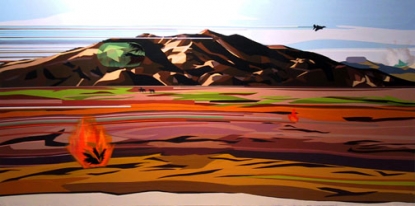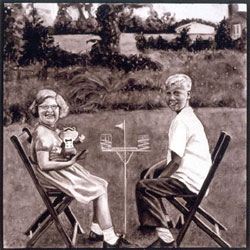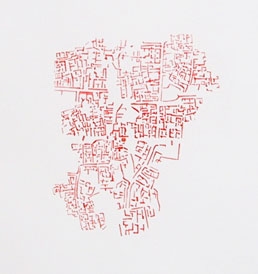Feature: Reviews
Introductions 2003
- Toomey Turrell Fine Art, Catharine Clark Gallery, Heather Marx Gallery, Patricia Sweetow Gallery, Gallery Paule Anglim, John Pence Gallery
- San Francisco
July 8 - August 2, 2003
reviewed by Olaniyan Adams
This summer marked the twenty-fourth year of Introductions, a series of concurrent gallery exhibitions where promising San Francisco Bay Area emerging artists took central stage for the viewing public. This year, much of the more interesting work dealt with traditional media - namely painting. The old schools of figuration and abstraction were evenly represented, with smart examples of both to be found. Introductions 2003 showcased a vector in art production wherein technique and well-honed skills take the place of broad, over-extended gesture. Much of the work seems to share a common thread of being influenced by attenuating elements of contemporary life such as the ubiquity of technology (e.g. screens, networks, monitors, photographs, media), alcohol, and a supposedly victorious military’s machines.
Maria Park presented a lushly colored and polished series at Toomey Turrell Fine Art, offsetting Technicolor striations with supersonic shadows of poignancy and uncertainty. In these lacquered works of rupturing velocities, F-15 jet fighters appear like the skeleton keys to discord. Her colorful strata, resembling suspended motion streaks, were both lovely and, in combination with jet fighters, troubling. The works recalled the futurists’ obsession with the merger of action, speed and violence and blurred, hastened sensations, with a beauty of the most disruptive and threatening kind.
At Catharine Clark, Tommy Becker drew humor and enjoyment out of the inquisitions of the machines he portrayed. Clearly artificial, robotic voices functioned as repetitive interrogators of static images of masculine and feminine figures. Using video, performance and props, Becker’s work is seemingly inspired by European electronic music (e.g. Air). Funny, disgusting, yet realistic in the portrayal of the sadistic interaction between human and machine (after the film Tetsuo), Becker stirs series of conflicting feelings in the viewer - humor, mockery, teasing - all tied up in a fun-loving but cruel bundle.
In Clark’s largest atrium, Josephine Taylor showed a series of gargantuan, feathery drawings of couples caught up in delectable moments. Using pastel shades, fine lines and a delightfully distorted sense of proportion and scale, the artist turned these moments of couplings into alien singularities that verged on the terrifying for reasons beyond the mere scale of the work. These “big-little” saurian works, full of minute details, instill wonder. Though large, their size was juxtaposed with obsessively fastidious rendering that together accomplished a real sensation of the sublime.
David Lyle presented a series of black and white paintings at Heather Marx. Painted from photographs of families at their oddest instants, the work was kitschy (in the sense of monumentalizing familiar nuclear memories with quotidian origins) and overtly alluded to the photographs of Diane Arbus. This familiar idolization of the bizarre instant was openly derivative and untenable for prolonged viewing. Lyle seemed to want to make images like or after photographs while not being as faithful to the source material as an actual photorealist might be. The work seemed an almost anti-technical statement, as if Lyle purposely painted terribly, much like David Salle would if he were to pointedly avoid and neglect color sense.
Meticulous and demanding abstractions had their day at Patricia Sweetow. Two stand-outs were Marietta Hoferer and Laura Ann Horelick. Hoferer works with patterns existing somewhere between the invention of the grid and the nature of snowflakes. Influenced by Eastern practices such as yantra yoga, these intricate, quiet pieces had a certain mystique, a non-literal, sophisticated aura, creating satisfying unattainability. Horelick also explored indefinite space, a Borgesian area where half formed, letter-like inscriptions create networks that become iron gates, lingering between sign and design.
Several painters exhibited at Paule Anglim, among them Joshua Podoll, Madison Smith and Sian Oblak. Joshua Podoll’s welcome end to knowing series are painted faux monitors glowing with supersaturated colors. Podoll mocks the pervasions of the small screen. His fuzzy, all-over surfaces obliquely echo the surfaces and atmosphere of Vermeer. Madison Smith offered small and pointedly underdeveloped paintings of saplings. Governing spaces that are both representational and abstract, Smith balanced the two painterly states, showing off her skills at depiction while contradicting her ambition to recall Renaissance gestures. Sian Oblak also seemed to want balance - a desire to represent with the simple beauty of her chosen material, paint. Using fragments of realism as touchstones for explorations of the material, well rendered draperies (the bane of every novice painter), Oblak’s pastel and bold, yet feminine explorations conveyed a sense of painterly bravery that may someday approach the masteries that inspired her.
Travis Schlaht showed work in the figurative tradition at John Pence. Schlaht, a product of Brooklyn’s Water Street Atelier, presented still lives of flowers in vases and nudes. As trite as his subject matter may sound, the way he dealt with his subjects and the technical expertise he revealed was a refreshing, viable way of revealing the scaffolding of ordinary yet universal human experiences. The Morandi-like arrays of bottles and other drinking paraphernalia offered up plays of light taupes and dark grays, whites and browns which alternate with a restrained yet completely savory sense of color. Schlaht’s nude studies were well proportioned and natural, revealing the buttery beauty of the material. Schlaht’s accomplishment is manifold, showing technical veracity and the ability to convey a sense of paint’s still enthralling nature as a material. Though ultra traditional - not about pushing boundaries - Schlaht describes creative, destructive human lives, the paint and the drink that both sustain and consume them.



